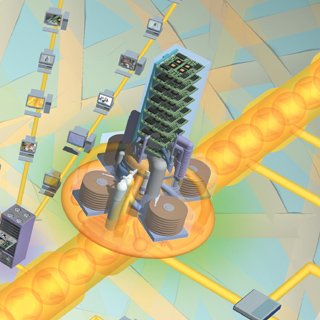Chapter 1. What Is the Internet?
| One of the most frequently asked questions about the Internet is "Who runs it?" The truth is that no centralized management of the Internet exists. Instead, it is a collection of thousands of individual networks and organizations, each of which is run and paid for on its own. Each network cooperates with other networks to direct Internet traffic so that information can pass among them. Together, these networks and organizations make up the wired world of the Internet. For networks and computers to cooperate in this way, however, a general agreement must take place about things such as Internet procedures and standards for protocols. These procedures and standards are laid out in requests for comment (RFCs) that are agreed on by Internet users and organizations. A variety of groups guide the Internet's growth by helping to establish standards and by educating people on the proper way to use the Internet. Perhaps the most important is the Internet Society, a private, nonprofit group. The Internet Society supports the work of the Internet Architecture Board (IAB), which handles much of the Internet's behind-the-scenes and architectural issues. The Internet Engineering Task Force (IETF) is responsible for overseeing how the Internet's TCP/IP protocols evolve. For information about the IETF, go to www.ietf.org. (See Chapter 3, "How TCP/IP Works," for details on TCP/IP protocols.) The World Wide Web Consortium (W3C) develops standards for the evolution of the most well-known part of the Internet, the World Wide Web (find it at www.w3.org). The W3C is an industry consortium run by the Laboratory for Computer Science at the Massachusetts Institute of Technology (MIT). Private companies oversee the registration of Internet domains, such as www.zdnet.com or www.quepublishing.com. These companies, called registrars, all must cooperate with one another to ensure that only one person or company can own a particular domain and that all the domains work properly. The registrars compete with one another as well in allowing people and businesses to register domains. Registering a domain costs money, and the registrars compete on cost and on giving extra services to those who buy domains. Although all these types of organizations are important for holding together the Internet, at the heart of the Internet are individual local networks. These networks can be found in private companies, universities, government agencies, and online services. They are funded separately from each other and in a variety of manners, such as fees from users, corporate support, taxes, and grants. Many Internet service providers (ISPs), which provide Internet access for individuals, have networks as well. Individuals who want to access the Internet pay ISPs a monthly connection rate, so in that sense, everyone who uses the Internet helps pay for it. The networks are connected in a variety of ways. For efficiency's sake, local networks join in consortiums known as regional networks. A variety of leased lines connect regional and local networks. The leased lines that connect networks can be as simple as a single telephone line or as complex as a fiber-optic cable with microwave links and satellite transmissions. Private companies who make money by selling access to their lines build backbones, which are very high-capacity lines that carry enormous amounts of Internet traffic. Government agencies, such as NASA, and large private corporations pay for some of these backbones. The National Science Foundation also pays for some backbones. |
EAN: 2147483647
Pages: 223
